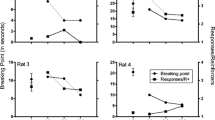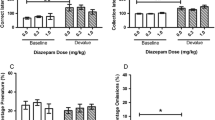Abstract
Negative contrast that occurs when rats are shifted from 32% to 4% sucrose was reduced by IP injections of ethanol (1.0 g/kg) on postshift day 2, but not on postshift day 1. Smaller doses (0.25 and 0.5 g/kg) were ineffective, while larger doses (1.5 and 2 g/kg) produced sedation. A dose of 0.75 g/kg had effects similar to the 1.0 g/kg dose when administered on post-shift day 2. These results parallel those obtained with chlordiazepoxide and differ somewhat from amobarbital treatment.
Similar content being viewed by others
References
Barry III H, Miller NE (1962) Effects of drugs on approach-avoidance conflict tested repeatedly be means of a “telescope alley”. J Comp Physiol Psychol 55:201–210
Barry III H, Wagner AR, Miller NE (1962) Effects of alcohol and amobarbital on performance inhibited by experimental extinction. J Comp Physiol Psychol 55:464–468
Brimer CJ (1972) Disinhibition of an operant response. In: Boakes RA, Halliday MS (eds) Inhibition and learning. Academic, London, pp 205–227
Brown JS, Mansfield JG, Skurdal AJ (1980) An interference-reduction theory of the effects of ethanol on conflict behavior. Physiol Psychol 8:423–432
Flaherty CF, Becker HC, Driscoll C (1982) Conditions under which amobarbital sodium influences contrast in consummatory behavior. Physiol Psychol 10:122–128
Flaherty CF, Blitzer R, Collier GH (1978) Open-field behaviors elicited by reward reduction. Am J Psychol 91:429–443
Flaherty CF, Capobianco S, Hamilton LW (1973) Effect of septal lesions on retention of negative contrast. Physiol Behav 11:625–631
Flaherty CF, Driscoll CD (1980) Amobarbital sodium reduces successive gustatory contrast. Psychopharmacology 69:161–162
Flaherty CF, Lombardi BR, Wrightson J, Deptula D (1980) Conditions under which chlordiazepoxide influences gustatory contrast. Psychopharmacology 67:269–277
Lombardi BR (1980) Enhanced neophobia induced by incentive contrast. Anim Learn Behav 8:617–620
Lombardi BR, Flaherty CF (1978) Apparent disinhibition of successive but not simultaneous negative contrast. Anim Learn Behav 6:30–42
Mathers DA, Barker JL (1980) (-)Pentobarbital opens ion channels of long duration in cultured mouse spinal neurons. Science 209:507–508
Meinrath AB (1980) The role of neophobia in successive negative contrast: Effects of early handling and varied taste exposure. Doctoral dissertation, Rutgers University (1980)
Nestoros JN (1980) Ethanol specifically potentiates GABA-mediated neurotransmission in feline cerebral cortex. Science 209:708–710
Skolnick P, Paul SM, Barker JL (1980) Pentobarbital potentiates GABA-enhanced (3H)diazepam binding to benzodiazepine receptors. Eur J Pharmacol 65:125–127
Vogel JF, Principi K (1971) Effects of chlordiazepoxide on depressed performance after reward reduction. Psychopharmacology 21:8–12
Author information
Authors and Affiliations
Rights and permissions
About this article
Cite this article
Becker, H.C., Flaherty, C.F. Influence of ethanol on contrast in consummatory behavior. Psychopharmacology 77, 253–258 (1982). https://doi.org/10.1007/BF00464576
Received:
Accepted:
Issue Date:
DOI: https://doi.org/10.1007/BF00464576




